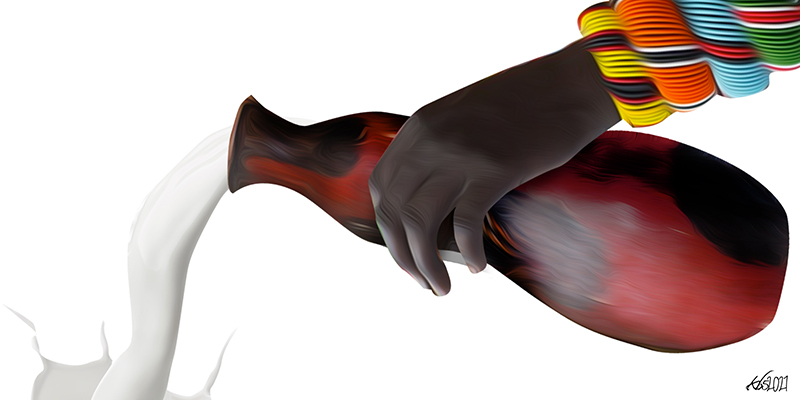My friend is having a Samburu traditional wedding and I attend in earnest glee; food was not the centre of that wedding. I remember how after waiting an inordinate number of hours for any signs of food preparation, at around 1 p.m. my friend said “there goes your stew” and I saw some way from us a few morans leading a goat towards the acacia thicket by the dry riverbed. A moran pilau was hastily put together. We were served in Jerry cans that had been cut in half. The morans used their knives to cut spoons out of tree bark and we ate like men about to go to war. We then lay under the trees as the morans sat in pairs preening their looks and adjusting their hairpins. Later they danced under the acacias, the morans in their colourful socks jumping endlessly well into the wee hours of the next morning, fuelled by the pilau from lunch. No wonder the morans were trim, without any superfluous flesh on their wiry bodies.
On another occasion, amongst the Gabra whose marriage calendar falls twice a year, with hundreds of traditional weddings being held across the land on the same day, goats were slaughtered in such numbers that for a few days afterwards you could not look at beef or goat meat with any appetite.
In the north, guided by the moon and the seasons, it was ritual that largely dictated the slaughter of goats. During the circumcision ceremonies late last year, thousands of goats were slaughtered within the span of a few days. At an age set transition ceremony amongst the Rendile a few years ago, everyone who was transitioning slaughtered a goat, thousands of them in just a couple of days. A friend ran behind a thicket and brought me back a badly roasted whole goat’s hind leg and a moran’s knife. This was how pastoral nomads partook in goat and beef consumption.
Goats died en masse during Almado and Sorio and then the rest of the year people subsisted on milk, porridge, boiled maize and ilkitegee — ugali with dollops of fat and sugar. The calendar of these ceremonies coincided with important seasonal changes. The slaughter of goats in large numbers played an important role in creating an ecological balance as this eased the pressure on pastureland and water resources.
Goats were slaughtered in such numbers that for a few days afterwards you could not look at beef or goat meat with any appetite.
In this land of uncertainty, complex safety nets had emerged to distribute risk and guard against uncertainty. Meals reflected this spirit of sharing at the micro level; one never ate alone, and food was served in large sinias with six people sitting around a single plate. Aphorisms like “if shared, a flea can make two bites” were often repeated.
Yet, with climate change, the image coming out of northern Kenya is one of starvation. Extreme seasonal changes have increased uncertainty and the frequency of drought-induced famine. This year, the March-April long rains were dismal and already stories of looming hunger are beginning to circulate, with 40,000 people said to be facing starvation in Marsabit.
Flanked on one side by the Kenyan highlands, which are known for large-scale cash crop plantation agriculture, and by the teff and corn-growing Ethiopian highlands on the other, one wonders why the dominant image emerging out of this large swathe of low shrubland is one of starvation.
Over the years though, efforts have been made to transform this image without however taking into account the complex dynamics at play. The common policy response has always favoured — or has been geared towards — changing pastoral nomadism by introducing crop agriculture. For a country like Kenya, where agriculture contributes a third of the country’s Gross Domestic Product, crop agriculture seems to be the government’s default setting and in this mode, pastoral nomadism has been vilified as both outdated and as unsustainable as a means to a livelihood. Unending efforts have been dedicated to bringing change and NGOs compete with each other in handing out greenhouses and irrigation equipment. Youth groups are trained in modern poultry farming methods and women’s groups are given beehives to start beekeeping. Wreckage from these efforts dots the landscape.
Sedentary meals
As nomads became increasingly sedentary, new economic pursuits emerged which demanded a massive dietary readjustment. Caloric needs increased and palates developed new tastes. As people settled and moved to salaried and wage labour, food security at the household level improved greatly. Rice, spaghetti, chapati and macaroni served with beans, meat and potatoes were the meals consumed in most towns in northern Kenya throughout the year. Most of these were foods were lacking in fibre, leading to unique health problems. Bowel movement is hampered and many suffer from hemorrhoids in secret; it is a common health complaint in the urban centres that is further exacerbated by miraa consumption.
With food security achieved for the settled populations, more meat was consumed in the urban centres, a big departure from the pastoral dietary habits. “If a meal doesn‘t have meat in it, is it even a meal?” seems to be the unasked question sitting unanswered on each plate. The Marsabit Integrated Smart Survey of 2019 showed that consumption of animal protein-rich foods was so high that health practitioners warned Marsabit residents against eating too much beef.
A history of farming in Marsabit
According to the Marsabit Statistical Abstract published by the Kenya National Bureau of Statistics (KNBS), 16,000km² around Marsabit is arable land. Mr Woche Guyo, a historian from Marsabit, has been keenly following the agricultural patterns in the region and says, “Those who remembered the history of farming in N. Kenya would recall the British were very much interested in N. Kenya food sufficiency. Up to 1914 the British (colonial administrators stationed in northern Kenya) were buying food directly from Abyssinia, as Ethiopia was known then. The death of Emperor Menelik and the SUCCESSION struggle complicated matters for the British.) The permanent solution came in 1920. The Burji AND the Konso provided a permanent solution.”
The British brought Burji farmers from Ethiopia and settled them around Mt. Marsabit to start farming on the lush montane. The Burji came with their cereal-rich meals like fiqe, kurkurfa, qanchebello, qita, thabo, buthena, and they introduced the moringa tree — shalqetha became the flag by which Burji households were identified.
The slaughter of goats in large numbers played an important role in creating an ecological balance as this eased the pressure on pastureland and water resources.
The variety of foods Burji farmers brought to Kenya introduced an important change to the food habits of the pastoral nomads, adding cereals and grain to their staple diet of milk and meat. This was achieved long before relief food became a fixture in the north’s uncertain food calendar. These culinary changes also forced the pastoral nomads in Marsabit and Moyale to diversify into small-scale mixed agriculture. Back in Ethiopia, the Burji are still expert farmers. On a trip to Burjiland a few years back, I was invited to a wedding where I sat with elders and we were served bean stew and anjera made from brown teff, which we washed down with barley beer. In Kenya Burji weddings were affairs where meat and rice had to be served.
By the 1980s, with increasing droughts, Mr Woche was writing articles about farming with titles like Making the Desert a Land of Plenty and Rendile Put Down Farm Roots for the daily newspapers. Through these articles, he traced the history of nomads branching into crop farming in Marsabit. “By the end of the second world war, Marsabit was becoming the granary of the Northern Frontier District,” he wrote in 1982. “Main crops grown are maize, wheat, coffee, pigeon peas, cow peas, njahi, Ethiopian finger millet, teff, sorghum, sweet potatoes and cassava”. Everything can and did grow in Marsabit.
But the frequent droughts and famines were wreaking havoc. More and more destitute nomads were shifting from pastoralism to crop farming. Every drought came with its own feeding centre which eventually grew into a settlement. The main intervention at these feeding centres was to place a hoe in the hands of the newly destitute. The settlement pattern around Mt. Marsabit can be traced to past famines and feeding schemes.
Nomadic herders have also been forced by climate change to rethink their economic livelihoods, and by adopting crop agriculture, many have risked alienation in order to fit into their new way of life. These pioneers have become true agro-pastoralists, adding to their resilience cap the feather of dynamism.
Songa, an agricultural Rendile village, was started in 1979 and was by the 1990s feeding itself and selling surpluses of kales, tomatoes, and juicy mangos in Marsabit town. The Songa exemplar is repeated in Badassa, Drib Gombo and Gabra Scheme areas. Much of the 16,000km² arable land has however been abandoned with most of it now lying fallow or planted with the evergreen miraa trees.
Farming success
Farming became so successful that storage for cereals in Marsabit was inadequate and tonnes of maize from the region were stored at the Cereals Board in faraway Meru. Bananas from Marsabit won prizes at agricultural shows in Embu for their world-class quality.
“My father and his friends were bringing in tractorfuls of maize over several days,” says Woche, “but that was in the good days when the climate was okay.”
In those years Marsabit received rain almost all year round, making it hard to dry maize and forcing those growing it around the town to take it to the lowlands for drying, 30 kilometers away. Stories of food donations being taken from the Marsabit Cereals Board granaries to places like Malawi are told with a touch of nostalgia now. Yet there was no investment in the agricultural sector then. Even now, many decades later, the same problems persist in the crop agriculture sector; hardly any technology is in use and few investments are made.
The settlement pattern around Mt. Marsabit can be traced to past famines and feeding schemes.
NGOs have led the efforts in food production and in Garissa individuals have established irrigation schemes along the Tana river, which has led to an explosion of farming activities. This in turn has led to an influx of farmhands, with hundreds of Luhya labourers from western Kenya working on farms in Garissa. In Marsabit the more experienced and effective farm labourers are from Meru and even the Burji, who used to do all the work on their farms themselves, now hire Merus to work for them.
Cushioning against social shocks
Funerals in the north offer an interesting crucible through which to examine how social safety nets work. At a funeral, a cow is slaughtered and its meat is boiled in large chunks with no spices added lest one develop a taste for the meal and start wishing for regular funerals. After the burial, hundreds of people head to the household of the bereaved and for a brief moment funereal gloom turns into a gloomy feast as people eat, joyless looks on their faces as they roll morsels of white, spiceless rice with their fingers and partake of the boiled beef.
“We have eaten so and so’s rice” often remarked after the death of a friend means “he is finally gone”. The finality of their existence and departure is captured in the partaking of that rice.
Yet the beef and white rice business at funerals is a new affair for the Burji. Even as late as the mid-1990s, when someone died people prepared meals and took some of it in bowls to the household of the bereaved. There was no pressure to bring anything fancy and one brought their usual meals. Rice, qita, fiqe, githeri, kurkurfa and buthena dishes prepared in different households were brought and served to the relatives of the bereaved for a whole week. This practice was referred to as bochocha by the Burji, a tradition they had brought with them from Ethiopia, a safety net that meant that funerals didn’t require substantial resources or put the bereaved in any unnecessary debt.
But as new urban prosperity emerged so too did new funeral rituals. Shumo, boiled maize, was rejected and a cow had to die no matter the status of the departed, leading to high send-off costs and debts to be repaid. Instead of pooling food, now people contributed 50 shillings for any community member who died.
Stories of food donations being taken from the Marsabit Cereals Board granaries to places like Malawi are told with a touch of nostalgia now
There is an ongoing debate about the slaughter of cows at funerals. It started from Wahhabist quarters, sparked by sheikhs from the new mosques who argue that there is a need to keep funeral costs down, that people who are in mourning should not be involved in the logistics of sourcing for cows, rice and firewood, that no fire should be lit in the household of the bereaved, and that no debts should be incurred.
This suggestion to change funeral traditions has the ecologists amongst us arguing for the ecological role played by the killing of cows at funerals, that in this manner a necessary balance between the human population and the cow population is achieved. The mercantilists argue that the livestock trade depends on funerals and marriages; funerals have evolved to play a big part in the demand-side of the livestock trade in the region. Yet others argue for the army of destitutes who keep an ear to the ground for news of funerals where they can eat a decent meal and carry some food back home in paper bags.
Food changes, changing foods
The landscape changes, the tractors in the rapidly vanishing farmlands upend the ox-drawn plough, Meru youths with their pangas working in pairs replace groups of Borana men as cheaper, more experienced labour. The panga and the agility of its user bring a more convenient efficiency as does the demand of an impatient urban dweller to whom a meal of cooked beans packed in a paper bag is sold.
The stoic if philosophical look of the nomad in the grasslands besides his/her goat alters its shape in the town. The role that traditional waist beads played in measuring the nutritional and health status of children has now been left to community health workers or volunteers who go around the villages with MUAC tapes taking arm measurements and prescribing Plumpy’Nut.
In the arable lands of Marsabit, old fruit and moringa trees are cleared and farms subdivided into tiny plots to meet the growing demand for housing. This changing land utility parallels the changing diet in the region.
Taboo foods
In the past, some clans did not eat poultry meat and in parts of Marsabit poultry was kept only for trade. But these taboos are lifting and we are seeing an increase in the consumption of traditionally forbidden foods, further contributing to food security. For many years, the region didn’t provide the necessary market for fish from Lake Turkana which ended up in markets as far away as Burundi and Congo. But this too is changing as the communities continue to embrace new foods.
Facing the future
Northern Kenya has seen a significant rise in population in the last 50 years. The demographic changes that have emerged with education, the growth of towns and changing lifestyles have led to a bigger change in crucial survival strategies which are the result of a combination of the NGO-led introduction to crop agriculture, the agriculture-oriented income-generating activities of youth and women groups, and kitchen gardens. Slowly, northern Kenyans are acquiring practical skills in a region that had previously never engaged in crop agriculture. Kina in Isiolo has become an irrigation farming haven.
Opening up the road networks means that vegetables from the Kenyan highlands can now reach hitherto inaccessible areas, with boda bodas and probox vehicles crisscrossing the northern plains with fresh goods every morning, although Ethiopia also offers a cheaper alternative to Kenyan agricultural produce.
–
This article is part of The Elephant Food Edition Series done in collaboration with Route to Food Initiative (RTFI). Views expressed in the article are not necessarily those of the RTFI.








